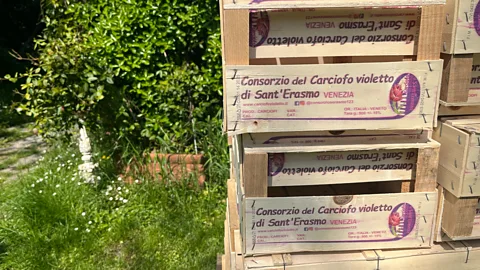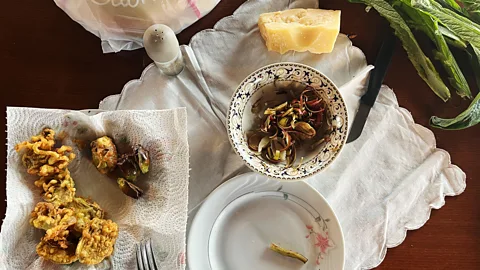Because they’re so delicate, the castraùre don’t get exported far out of the lagoon and are usually harvested, sold and eaten in the same day. Camerino sells directly to restaurants in Venice that “understand the quality” of the product. The problem, she says, is that many restaurants in Venice have stopped buying real castraùre “because they’re expensive and non-local customers can’t tell the difference. So they use normal artichokes but pretend they’re castraùre so they can hike up the prices.”
 Catherine Bennett
Catherine BennettHow to try castraùre
• Plan a trip to Venice around mid-April to hit the height of the castraùre season.
• Always ring ahead to see if restaurants are serving them, since it’s so dependent on the harvest.
• If you want to try preparing them at home, make sure you only buy artichokes with the consorzio’s label – and don’t be afraid to grill the seller about where they come from.
• If you miss the season, don’t worry; you can buy a jar of violet artichokes preserved in oil from Finotello’s farm on Sant’Erasmo.
• You can also get them in liquid form: the amaro digestif Venesian is made from Sant’Erasmo artichokes. Pick up a bottle to take home at the delicatessen Maramao, which sells local products from its canalside shop in the Cannaregio district.
Al Covino, a Venice restaurant that focuses on local produce and traditional ingredients recognised by Italy’s Slow Food presidium, makes a point of serving the castraùre when they come into season. It’s a cosy space with pistachio-green roof beams, hanging plants and only 15 covers, hidden on a small street in the city’s Castello neighbourhood and run by husband-and-wife team Claudio De Lauzieres and Claudia Torcellan. De Lauzieres, a Neopolitan who has been living in Venice for 12 years, rhapsodises about the local ingredients with a boyish enthusiasm: “Neapolitan cuisine is much more well-known than Venetian cuisine, but the lagoon offers so many different environments and unique tastes. The castraùre symbolise the richness of the land here.”
He prepares three castraùre dishes: a silky, gently sautéed version that doesn’t just melt on the tongue but entirely disappears, leaving a subtly sweet aftertaste; tagliolini in a velvety artichoke sauce; and raw shavings of the vegetable in a salad with oil, parmesan and a hint of lemon zest. He watches my face as I take a bite of the salad and grins at my expression of surprise at the tiny bud’s powerful taste. Its flavour instantly takes me back to Camerino’s boat and the smell of the salty lagoon air whipping past my face.
On Sant’Erasmo, local farmer Carlo Finotello has been working for years to crack down on the falsely labelled castraùre that appear in markets and shops across the lagoon. He runs the farm I Sapori di Sant’Erasmo with his brother Claudio and is also the president of the Consorzio del Carciofo Violetto di Sant’Erasmo, a consortium created in 2004 to promote the local violet artichoke. Its label is a mark of quality and authenticity.
“Some vegetable sellers take the consorzio label and stick it on other crates of normal artichokes,” Finotello explained. “Or they will buy some castraùre but then mix them in with normal artichokes so they’re still making a bit extra.”
 Catherine Bennett
Catherine BennettWhen the consortium receives a tip-off about producers passing off Tuscan artichokes as the Sant’Erasmo version, Finotello contacts them directly to ask them to desist – but the consortium isn’t a policeman, he says, and they have no power to issue fines, nor the time or money to take them to court. He says that it’s vital to only buy castraùre from a local producer, and to always make sure that they have the consortium’s label, in order to protect the centuries-old tradition of growing them.